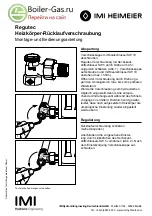
GENERAL INSTALLATION
COLD MAINS PIPEWORK
Run the cold main through the building to the place where the iSteel is to be installed. Take care not to run the cold pipe
near hot water or heating pipe work so that the heat pick up is minimised. Identify the cold water supply pipe and fit an
isolating valve (not supplied).
A 22mm BS1010 stopcock can typically be used but a 22mm quarter turn full bore valve would be better as it does not
restrict the flow as much. Do not use “screwdriver slot” or similar valves.
Make the connection to the cold feed of the cylinder and incorporate a drain valve. Position the inlet control just ABOVE
the Temperature & Pressure Relief Valve (TPRV) mounted on the side of the cylinder. This ensures that the cylinder does
not have to be drained down in order to service the inlet control set. Ensure that the arrow points in the direction of the
water flow.
Select a suitable position for the expansion vessel. Mount it to the wall using the bracket provided. Use the compression
connection supplied to connect the vessel into the cold water pipe adjacent to the cold feed point on the cylinder. There
must be no obstruction or flow restriction between the cylinder and the expansion vessel.
BALANCED COLD CONNECTION
If there are to be showers, bidets or mono-bloc taps in the installation then a balanced cold supply is necessary. There is
a 22mm balanced connection on the inlet control set. All outlets in the house will be at 3 bar and thus automatically
balanced.
HOT WATER PIPEWORK
Run the first part of the hot water distribution pipework in 22mm. This can be reduced to 15mm and 10mm as appropriate
for the type of tap etc. Your aim should be to reduce the volume of the hot draw off pipework to a practical minimum so
that the time taken for the hot water is as quick as possible.
Do not use mono-bloc mixer tap or showers if the balanced cold connection is not provided, the unit will back pressurise
and result in discharge. Ensure that the top of the vessel is accessible for servicing.
PRIMARY COIL CONNECTIONS (INDIRECT ONLY)
Compression connections are provided for the primary circuit which must be positively pumped. Primary flow and return
connections are interchangeable to suit site conditions without affecting reheat times. These connections are metric and
should be changed by the installer if using Irish size copper tube.
Sealed or vented primary circuits can be used, to comply with normal installation practice the primary pressure should
not exceed 3 bar although the coil in the iSteel is suitable for up to 7 bar if required. The boiler may be Gas, Electric, and
Oil etc. but must be under effective thermostatic control. Uncontrolled heat sources such as some AGA’s, back boilers,
solid fuel stoves, etc. may not be suitable please contact us for guidance. The two port zone valve should be installed into
the primary flow pipework leading to the coil flow inlet. The direction of flow arrow should be towards the primary flow
connection. On twin coil cylinders an extra thermostat boss is provided.
SECONDARY CIRCULATION
Where secondary circulation is required a circulator suitable for potable water should be used in conjunction with a non-
return valve to prevent backflow. It may be necessary to incorporate an extra expansion vessel into the circuit to
accommodate the increased system water volume in larger secondary circulation systems. Where off peak electrical
tariffs are being used then secondary circulation should be avoided. A secondary return boss is fitted as standard on 210,
250 & 300L. On smaller sizes tee into the cold feed pipe above the drain.
IMMERSION HEATERS
As a requirement of Building Regulations the iSteel immersion heaters are fitted with thermal cut-out in addition to the
normal control thermostat. To help ensure correct replacement the immersion heaters have a special 1¾" thread. They
are of a low noise Incoloy construction and rated at 3 kW at 240 V. Replacement immersion heaters should be purchased
via ourselves otherwise your guarantee may be affected. For commercial / heavy duty installations where constant usage
/ reheat is required Titanium immersion heaters must be fitted in order to comply with the warranty.
The ‘O’- ring on the head of the immersion heater should be correctly positioned and lubricated before fitting. Screw in
hand-tight until almost sealed then gently tighten as the ‘O’ rings will seal easily. The electrical supply to each immersion
heater/s must be fused at 13A via a double pole isolating switch to BS 3456. The cable must be 2.5mm
2
heat resistant
(85°C HOFR) sheathed flex complying to BS 6141:1981 Table 8. Do not operate the immersion heater/s until the unit is
full of water. If any sterilisation liquid is in the cylinder do not operate the immersion heater/s as this will cause premature
failure. Electric to be supplied by a fused supply compliant with local regulations, and fitted by a qualified Part P
Electrician.
Summary of Contents for iSteel 120
Page 1: ...iSteel INSTALLATION MANUAL ISSUE 2015 V1 FOR MORE INFORMATION GO TO www atagheating co uk...
Page 11: ...INLET CONTROL GROUP Fault Finding Information...
Page 12: ...TUNDISH Fault Finding Information...
Page 13: ...T P RELIEF VALVE Fault Finding Information...
Page 14: ...DUAL THERMOSTAT Fault Finding Information...
Page 15: ...IMMERSION HEATER Fault Finding Information...
Page 16: ...ENERGY CUT OUT Fault Finding Information...
Page 17: ......
Page 18: ......





































